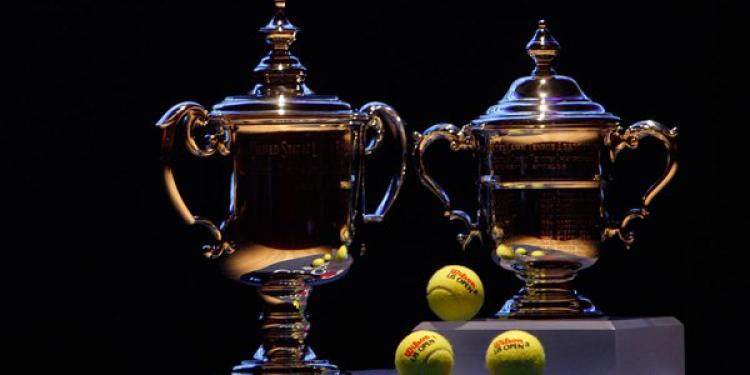The US Open Tennis Championship
Posted: August 26, 2014
Updated: June 4, 2017

From the souvenir of a young socialite to one of the richest sporting events in America the US Open has had quite a ride.
The first US Open was held in 1968 as the former segregation of the amateur/professional divide was brought down by a mixture of ugly connotation and fiscal considerations. Arthur Ashe was the winner beating Tom Okker, although the victor was a Lieutenant in the US Army and couldn't collect the $14,000 first prize portion of the $100,000 dollar pool, getting just $20 dollars per diem. It was at the time the richest tournament in tennis history and it was obvious from the start it would be something rather special.
The introduction of tennis to America is attributed to a young socialite called Mary Ewing Outerbridge who returned home from the isle of Bermuda with a game she'd acquired called Sphairstike. This was a boxed set of racquets, balls, a net and poles named after the Greek for “ball play” that had been marketed by a British Army officer by the name of Major Walter Clopton Wingfield and it had done much to publicize the game.
The appeal was towards those who might already own a flat piece of grass, perhaps for cricket or croquet, indeed it was the Staten Island Cricket Club that would host the first US championships, and proved very popular at the sort of parties held by people who might happen to have a croquet lawn in the garden. However from the time Mary Outerbridge laid out the first court in the US in 1874 it was obvious that the game would grow into something far larger.
The first American National Championship in 1880 was won by the altogether English O.E.Woodhouse when he defeated the Canadian I. F. Hellmuth for which he received a silver cup worth just $100, and the competition as a whole was replaced with the National Lawn Tennis Championship, which became the US Open, the very next year, and possibly due to a lack of mobile betting in those days, they held the first one on the grass courts of the Newport Casino in Rhode Island.
For those first years after 1881 only men from certain clubs were eligible to compete with the Women's National Singles Championship first held at the Philadelphia Cricket Club some six years later in 1887. This initial staging of the event was won by a local called Ellen Hansell despite being only 17 years old, and used a similar challenge system to the men's championship from 1888 all the way through till the end of the First World War.
The first schism in tennis came in 1911 when, led by Karl H. Behr a group of tennis players based around New York made inroads towards getting the tournament relocated to the city from Rhode Island's Newport Casino, but despite their best efforts the New York Times reported “The weakness in the position of those seeking the change, however, was the fact that they were unable to produce a bona fide application from any responsible club to hold the tournament”.
The relocation to issue didn't go away and in 1915, despite vehement defense of the Newport Casino venue, the contentious debate reached a fever pitch and binding vote that just barely passed the motion by129 votes to 119 (at the Waldorf-Astoria no less) to hold the event at the West Side Tennis Club, Forest Hills, New York. Which would perhaps become the spiritual home for tennis in the US gambling laws not allowing it to be tarnished at all.
In 1968 with damaging rumors abounding that there was skulduggery afoot in the amateur sport, with some players even reported to have been paid, and a determination on the part of those whose hands were on the purse strings, the four major tournaments allowed professionals to compete against amateurs and opened up the way for the Grand Slam events we know so well today. Although it was no simple hand over from the prior regime.
Promoters akin to Pyl ehad pretty much owned players and the game were still attempting to exercise control over the sport as a whole during this new “open era” and in a response to this alarming influence, that some said extended to those who bet on sports in the USA, the International Lawn Tennis Federation supported the formation of a Grand Prix of events, but this didn't prevent a prolonged battle between rival professional circuits.
This, frankly, got completely out of hand with promoters and associations fighting like parents at a custody battle, and in the end the players themselves stepped in, formed their own union, the Association of Tennis Professionals, in 1972 which attempted to rein in some of the silly excessive ego-thumping, finally culminating in the ATP Tour doing away with the Grand Prix title and creating the great playing framework of tournament, masters and grand slam events we enjoy watching today.
Read more about the game of tennis.
The first US Open was held in 1968 as the former segregation of the amateur/professional divide was brought down by a mixture of ugly connotation and fiscal considerations. Arthur Ashe was the winner beating Tom Okker, although the victor was a Lieutenant in the US Army and couldn't collect the $14,000 first prize portion of the $100,000 dollar pool, getting just $20 dollars per diem. It was at the time the richest tournament in tennis history and it was obvious from the start it would be something rather special.
The introduction of tennis to America is attributed to a young socialite called Mary Ewing Outerbridge who returned home from the isle of Bermuda with a game she'd acquired called Sphairstike. This was a boxed set of racquets, balls, a net and poles named after the Greek for “ball play” that had been marketed by a British Army officer by the name of Major Walter Clopton Wingfield and it had done much to publicize the game.
The appeal was towards those who might already own a flat piece of grass, perhaps for cricket or croquet, indeed it was the Staten Island Cricket Club that would host the first US championships, and proved very popular at the sort of parties held by people who might happen to have a croquet lawn in the garden. However from the time Mary Outerbridge laid out the first court in the US in 1874 it was obvious that the game would grow into something far larger.
The first American National Championship in 1880 was won by the altogether English O.E.Woodhouse when he defeated the Canadian I. F. Hellmuth for which he received a silver cup worth just $100, and the competition as a whole was replaced with the National Lawn Tennis Championship, which became the US Open, the very next year, and possibly due to a lack of mobile betting in those days, they held the first one on the grass courts of the Newport Casino in Rhode Island.
Bringing It On
Tennis in the United States Of AmericaBetween 1884 and 1911 the rules for the competition were very different from those we are used to seeing our favorite tennis stars adhere to today. The tournament used a challenged based system in which the previous year's winner automatically qualified for the final and merely played the winner of the all-comers tourney, which might explain why the first winner, American Richard Dudley “Dick” Sears, a student at Harvard at the time, went on to win seven consecutive titles.
• Introduced in 1874 by socialite
• Early tournaments played at casino in Newport
• Winners now make big gambling news
For those first years after 1881 only men from certain clubs were eligible to compete with the Women's National Singles Championship first held at the Philadelphia Cricket Club some six years later in 1887. This initial staging of the event was won by a local called Ellen Hansell despite being only 17 years old, and used a similar challenge system to the men's championship from 1888 all the way through till the end of the First World War.
The first schism in tennis came in 1911 when, led by Karl H. Behr a group of tennis players based around New York made inroads towards getting the tournament relocated to the city from Rhode Island's Newport Casino, but despite their best efforts the New York Times reported “The weakness in the position of those seeking the change, however, was the fact that they were unable to produce a bona fide application from any responsible club to hold the tournament”.
The relocation to issue didn't go away and in 1915, despite vehement defense of the Newport Casino venue, the contentious debate reached a fever pitch and binding vote that just barely passed the motion by129 votes to 119 (at the Waldorf-Astoria no less) to hold the event at the West Side Tennis Club, Forest Hills, New York. Which would perhaps become the spiritual home for tennis in the US gambling laws not allowing it to be tarnished at all.
The Split That Brought Us Together
Entrepreneur Charles C. Pyle established and promoted the first professional tour in 1926 and over the next forty years generated huge earnings for those that forsook the amateur game for the bright lights and large paychecks. Fred Perry, for example, earned $91,000 for a north American tour against Ellsworth Vines, that's around $1.5m in today's money, and compared very favorably with his $450 prize for his US Pro Tennis Championship win. It was this gaping chasm of difference that would finally unify tennis.In 1968 with damaging rumors abounding that there was skulduggery afoot in the amateur sport, with some players even reported to have been paid, and a determination on the part of those whose hands were on the purse strings, the four major tournaments allowed professionals to compete against amateurs and opened up the way for the Grand Slam events we know so well today. Although it was no simple hand over from the prior regime.
Promoters akin to Pyl ehad pretty much owned players and the game were still attempting to exercise control over the sport as a whole during this new “open era” and in a response to this alarming influence, that some said extended to those who bet on sports in the USA, the International Lawn Tennis Federation supported the formation of a Grand Prix of events, but this didn't prevent a prolonged battle between rival professional circuits.
This, frankly, got completely out of hand with promoters and associations fighting like parents at a custody battle, and in the end the players themselves stepped in, formed their own union, the Association of Tennis Professionals, in 1972 which attempted to rein in some of the silly excessive ego-thumping, finally culminating in the ATP Tour doing away with the Grand Prix title and creating the great playing framework of tournament, masters and grand slam events we enjoy watching today.
Read more about the game of tennis.
Related content
Subscribe
0 Comments












